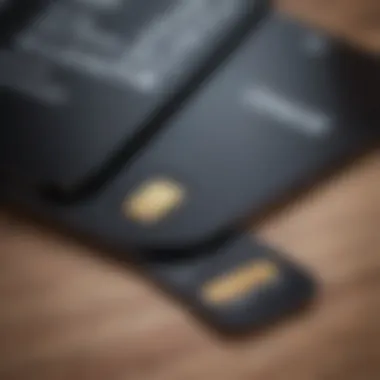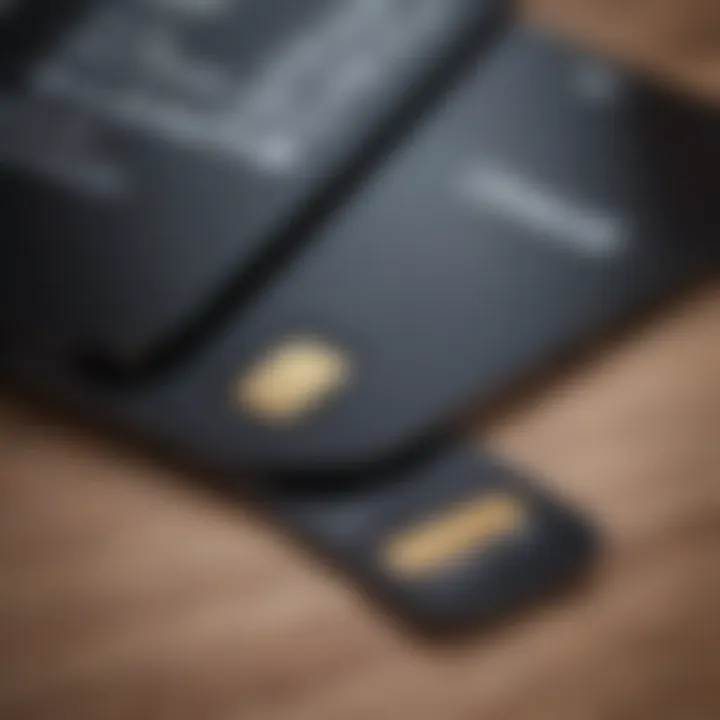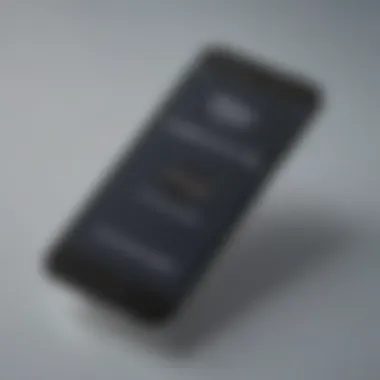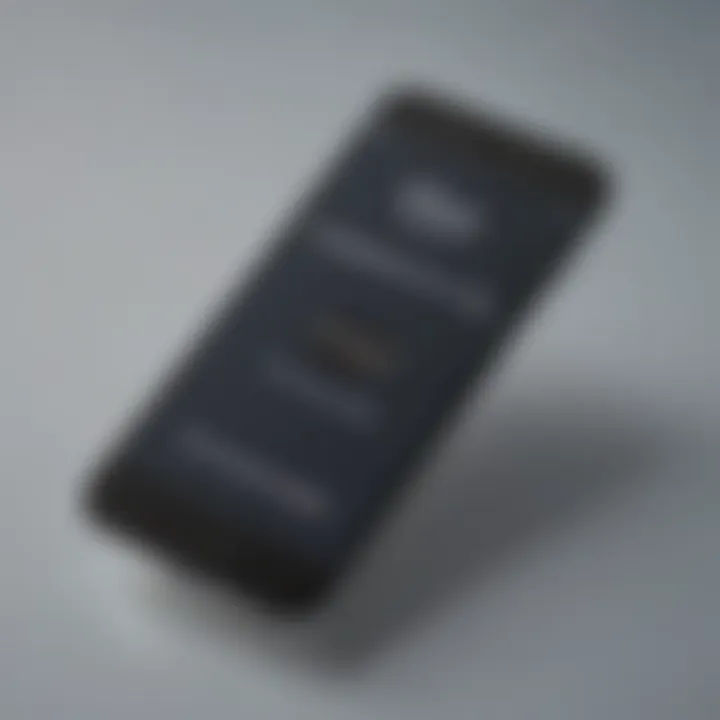Unlocking Your iPhone: The Black SIM Card Method


Intro
Unlocking an iPhone is a topic that attracts much attention among users. Many owners face the challenge of network restrictions imposed by mobile carriers. Utilizing a black SIM card to unlock an iPhone is one method that some may consider. This practice raises questions about functionality, legality, and the overall process.
In this article, we will explore the various aspects of using a black SIM card for unlocking. Step-by-step guidance will be provided, along with implications and potential risks. Additionally, alternative methods for unlocking an iPhone will also be discussed, allowing readers to weigh their options more effectively.
When considering this route, it is essential to have a comprehensive understanding of what it entails. With the right knowledge, users can make informed decisions while navigating the complexities of unlocking their devices.
Overview of Financial Product
Definition
In the context of iPhone unlocking, a black SIM card typically refers to a special type of SIM that bypasses the original carrier's restrictions. Its primary function is to allow users to utilize their devices with different carriers, which can be particularly beneficial for those who travel frequently or wish to switch providers.
Key Features
Some important features of a black SIM card include:
- Carrier Compatibility: Designed to work with various network providers.
- Ease of Use: Generally straightforward to install within the device.
- Cost Savings: Potentially reduces roaming charges and other fees by enabling local carrier use.
Purpose and Benefits
The main purpose of employing a black SIM card is to unlock an iPhone, thereby enabling greater flexibility with carrier choices. The key benefits include reduced costs associated with international travel, improved network coverage, and the ability to switch seamlessly between service providers.
Types and Categories
Pros and Cons
Like any method, using a black SIM card has its advantages and disadvantages. Some pros include the ability to save money on service plans and expand network options. On the other hand, cons may involve legality issues and the risk of device instability.
Situational Uses
This method is mainly useful for individuals who travel outside their home countries. Tourists and expatriates often seek ways to avoid exorbitant roaming fees. Additionally, it serves those who wish to take advantage of promotional plans offered by different providers.
Application Process
Steps to Apply
The process of using a black SIM card for unlocking typically involves:
- Procurement: Obtain the black SIM card from a reliable source.
- Insertion: Insert the SIM card into the iPhone following the proper method.
- Configuration: Configure the phone settings to recognize the new carrier.
Eligibility Requirements
There are usually minimal eligibility requirements. However, iPhone users should ensure that their devices are not iCloud locked.
Common Mistakes to Avoid
Users often overlook some critical aspects:
- Not checking compatibility with carriers before purchase.
- Failing to follow the correct installation procedure.
- Ignoring potential legal issues related to device unlocking.
Tips for Success
Here are some tips to consider:
- Always research the legal implications in your country.
- Seek advice from forums like Reddit for real user experiences.
- Keep all receipts and documentation for the black SIM card in case of disputes.


Costs and Fees
Types of Fees Associated
In addition to the upfront cost of the black SIM card, users may encounter various fees, such as:
- Activation Fees: Some carriers charge an initial fee for activating a new SIM.
- Monthly Plans: Costs associated with monthly service plans may vary.
Comparisons of Costs Across Options
Comparing costs across different methods of unlocking is crucial. While a black SIM may have an initial purchase price, it may save money in the long run compared to traditional unlocking services offered by carriers.
To make informed choices, consider both the immediate and long-term financial implications when unlocking your mobile device.
By understanding the intricacies involved in utilizing a black SIM card to unlock an iPhone, users are better equipped to tackle their mobile network challenges effectively.
Understanding SIM Cards
Understanding SIM cards is critical in the context of unlocking an iPhone. SIM cards, or Subscriber Identity Modules, play a central role in the functionality of mobile devices. They are essential for connecting your smartphone to a mobile network, allowing voice calls, text messages, and data services. An insight into SIM cards helps users grasp how unlocking processes function and the implications associated with each type.
What is a SIM Card?
A SIM card is a small card inserted into a mobile phone. It identifies the user on the network, securely storing essential information such as the user's phone number and account details. Each SIM card is linked to a mobile carrier, which provides access to services. Understanding its role is vital for users who seek to unlock their devices. An unlocked phone gives the freedom to use SIM cards from different providers, making it especially useful when traveling or switching networks.
Types of SIM Cards
Different mobile devices utilize various types of SIM cards, each with unique characteristics.
Standard SIM
The Standard SIM is the original size of SIM cards. It measures 85.6 × 53.98 mm, about the same size as a credit card. While it is largely outdated and replaced by smaller formats, its presence is still found in some older devices. The key characteristic of the Standard SIM is its size, which limits compatibility with newer smartphones that typically require smaller cards. Its primary advantage once was simplicity, but as technology evolved, it has become less relevant.
Micro SIM
Micro SIM cards measure 15 × 25 mm. They emerged as the transitional size to accommodate the demand for slimmer devices. The micro SIM is a popular choice among users who have phones like the iPhone 4 and 4S. Its smaller size allows manufacturers to design devices thinner while still providing essential connectivity. However, the need to use an adapter for older devices can be a disadvantage for some users.
Nano SIM
Nano SIM cards take miniaturization further, measuring only 12.3 × 8.8 mm. They are currently the standard for the latest smartphone models, including the iPhone 5 and beyond. The advantage of the Nano SIM lies in its compact size, enabling manufacturers to engineer devices with even more advanced technology and features. However, this also means it lacks the backward compatibility, which could be a problem when users switch back to older models.
Black SIM Cards
Black SIM cards represent a specific type of SIM designed with unlocking in mind. They differ from traditional cards in that they help bypass carrier restrictions on devices. The distinct feature of Black SIM cards is their capability to operate on various networks, allowing users to use their iPhones with different service providers. This is particularly advantageous for those looking to unlock their devices without going through conventional means. However, potential drawbacks include legal ambiguity and the risk of encountering network compatibility issues.
The Concept of Unlocking an iPhone
Unlocking an iPhone is a crucial process that allows users to freely use their devices across various networks. This section highlights the main components of unlocking, including its definition, benefits, and considerations. By understanding these elements, readers can appreciate the practical importance of unlocking an iPhone, particularly in relation to how utilizing a black SIM card can facilitate this process.
Definition of Unlocking
Unlocking an iPhone refers to removing software restrictions that prevent it from operating on networks other than the one it was originally tied to. When an iPhone is locked, it is typically restricted to a specific carrier, meaning that users cannot simply swap in a different carrier's SIM card and expect to make calls or access data. Unlocking essentially allows for greater flexibility in choosing carriers, enhancing the phone’s usability.
Reasons to Unlock an iPhone
Unlocking an iPhone has several benefits, making it a popular decision among users. Below, we explore the primary reasons for unlocking:
Traveling internationally
When traveling internationally, having an unlocked iPhone is highly beneficial. It allows users to purchase local SIM cards and avoid exorbitant roaming charges. This specific aspect of unlocking enhances overall convenience and reduces costs. By utilizing local networks, travelers can access data at much cheaper rates compared to their home carrier. Thus, unlocking ensures that users remain connected and can easily navigate their destinations.


Switching carriers
Switching carriers is another compelling reason to unlock an iPhone. Consumers often find themselves needing to change their service providers due to better plans or better service coverage. Unlocking their iPhones allows for hassle-free transitions between different carriers. This unique feature is appealing as it grants the user full control over their telecommunication options without being bound to a single provider. The advantage here is clear: users gain the freedom to choose the best deal for their needs.
Enhancing resale value
Unlocking an iPhone can also enhance its resale value. A locked iPhone may deter potential buyers who prefer the freedom of choosing their carrier. When an iPhone is unlocked, it attracts a broader market of potential buyers. The primary characteristic of enhancing resale value lies in the increased appeal of such devices. This advantage makes unlocking an intelligent financial decision for users who plan to sell or trade-in their phones in the future.
In summary, unlocking an iPhone opens doors to better travel options, carrier choices, and increased resale potential.
What is a Black SIM Card?
The term Black SIM Card often arises in discussions about unlocking smartphones, particularly iPhones. Understanding this type of SIM card is vital for anyone considering unlocking their device to gain more freedom and flexibility. Black SIM cards are not just additional mobile accessories; they serve specific purposes and come with various implications that users should be aware of before proceeding. In this section, we will break down the definition and purpose of Black SIM cards, as well as how they uniquely differ from standard SIM cards.
Definition and Purpose
A Black SIM card is primarily used to unlock devices from their original carrier restrictions. Unlike standard SIM cards, which are tied to a particular telecommunications provider, Black SIM cards are designed to bypass these limitations. Users often resort to them when they wish to switch networks or use foreign SIM cards while traveling abroad. The main purpose of these cards is to enable customers to use their devices on any compatible network, increasing the utility and longevity of their smartphones. Through this function, users can experience greater freedom in their mobile usage, which is increasingly important in our mobile-centric world.
How Black SIM Cards Differ
Black SIM cards differ significantly from regular SIM cards in terms of their functionality and the methods used to unlock devices.
- Functionality: While a standard SIM card connects a phone to a specific carrier's network, a Black SIM can manipulate network settings, allowing the device to interface with different providers.
- Security Features: Black SIM cards may not have the same security certifications or limitations as typical SIMs, which may lead to potential risks.
- Usage Restrictions: They may only be effective with certain phone models or under specific conditions, not guaranteeing universal compatibility.
It's crucial to approach the use of Black SIM cards with caution. They can indeed expand your access to telecommunication services but can also involve legal and technical complications. Users are encouraged to weigh the benefits against the potential risks and to understand the specific implications for their device. For additional relevant information on mobile networks and utilization of various SIM types, visit Wikipedia.
Using a Black SIM Card to Unlock Your iPhone
Using a black SIM card to unlock an iPhone is a topic of increasing relevance in today's tech landscape. Many users find themselves tied to one carrier, unable to switch to better options or international services. The significance of unlocking cannot be understated; it effectively liberates the device from restrictive agreements and offers the user choices that may save money in the long run. These choices include changing carriers when traveling or seeking better service plans.
Employing a black SIM card adds a layer of complexity and intrigue. It represents an alternative method that some users may not fully understand or may fear due to misinformation. A direct benefit includes the ease of accessing different network services without needing carrier approval. However, one must tread carefully, as there are several considerations to keep in mind, including legal aspects, the reliability of the tools used, and the risk of potential damage to the device. Understanding the step-by-step process and the specific tools necessary is vital for a successful operation.
Step-by-Step Process
To unlock an iPhone using a black SIM card, follow these steps:
- Obtain a Black SIM Card: First, secure the correct black SIM card compatible with your iPhone model.
- Insert the SIM Card: Power off your iPhone, insert the black SIM card, and restart the device.
- Connect to Wi-Fi: Wi-Fi is crucial at this stage for the unlocking process.
- Install Unlocking Software: Depending on the method chosen, install the required unlocking software that works in conjunction with the black SIM card.
- Follow On-Screen Instructions: Launch the software and follow the prompts to complete the unlocking process.
- Test the Unlock: Finally, test the unlock by inserting a new SIM card from a different carrier.
Required Tools and Resources
Black SIM Card
The black SIM card is an essential tool in the unlocking process. Its primary function is to bypass the carrier restrictions placed on the iPhone. What makes the black SIM card a beneficial choice is its ability to work independently of the original carrier's network. This characteristic allows users to effectively switch networks without needing authorization from their carriers. While this card can offer flexibility and access to various services, users must ensure they obtain it from reputable sources to avoid scams and ineffective products.
Unlocking Software
Unlocking software plays a pivotal role in the process of using a black SIM card. This software is designed to interact with the black SIM to unlock the iPhone's network restrictions. A key feature of reputable unlocking software is that it often provides a user-friendly interface that guides users through complex procedures. Choosing reliable and established software is critical, as poorly designed programs can lead to malfunction or data loss. Thus, it's wise to read reviews and seek recommendations before usage.
Internet Access
Internet access is necessary when using a black SIM card to unlock an iPhone. This requirement stems from the fact that the unlocking process often involves downloading additional data or communicating with server systems. A stable Internet connection not only facilitates these actions but also enhances the reliability of the unlocking software. The unique aspect of good Internet access is that it minimizes the risk of interruptions, which could complicate the unlocking process. Users should have a high-speed connection to ensure efficiency and success.
"Unlocking an iPhone can empower users with greater carrier flexibility and access to more favorable service plans."
Legal Considerations
When exploring methods to unlock an iPhone using a black SIM card, understanding the legal considerations becomes an essential part of the discussion. This section will clarify the legal landscape surrounding the use of black SIM cards and the implications involved in dealing with unlocking practices. These considerations are crucial, as they influence decisions regarding unlocking methods and highlight the potential consequences that users need to be aware of.
Legality of Using a Black SIM Card


The legality of using a black SIM card varies by jurisdiction. In some regions, using such tools to bypass carrier restrictions could be seen as illegal. Laws around telecommunications differ widely; therefore, it’s necessary to research local regulations before proceeding with this method. For instance, in the United States, the use of unlocking tools falls under the Digital Millennium Copyright Act (DMCA). This act provides specific guidelines on what can be done legally when it comes to unlocking phones.
Important Note: You should always consult legal experts or local regulations to understand fully whether using a black SIM card is permissible in your area.
Engaging with a black SIM card could lead to various consequences if it is deemed illegal. These consequences can range from fines to potential legal action from service providers. Simply put, understanding whether the method you intend to use is legal will safeguard you from future problems, enhancing the entire unlocking process.
Carrier Policies and Regulations
Carrier policies also play a significant role when it comes to using a black SIM card for unlocking your iPhone. Each carrier may have different rules regarding unlocking devices. Many carriers provide an official unlocking service for their customers, but the requirements can vary. Usually, unlocking your phone requires that it is fully paid off, and your account status must be in good standing.
Here are some common elements you may encounter:
- Eligibility Criteria: Different carriers may have specific requirements to determine if a device can be unlocked.
- Fees: Some carriers may charge a fee for unlocking services, while others do it free of charge.
- Time Frame: The unlocking process may take a few days, depending on the carrier's policies.
While a black SIM card serves as a potential shortcut for unlocking an iPhone, it may clash with the terms of service established by your carrier. Violating these terms can lead to service disruptions or penalties. Therefore, it’s wise to familiarize yourself with the terms imposed by your carrier surrounding unlocking practices. Doing so preserves a clear path ahead in navigating these complex scenarios.
Risks Involved
Potential Technical Issues
Using a black SIM card introduces several technical challenges that users should consider. Unlocking can fail for various reasons, including compatibility issues, outdated software, or errors during the unlocking process. Common technical issues might include:
- Carrier Restrictions: Different carriers implement unique restrictions. A black SIM card may not bypass these effectively, leading to failure.
- Software Conflicts: Outdated firmware on your iPhone can clash with the new settings introduced by the black SIM card. This can result in your iPhone being stuck in a looping update.
- Signal Problems: Users have reported reduced signal quality or connectivity issues when using black SIM cards. These problems can stem from poor programming or compatibility with local networks.
To mitigate these issues, always ensure your iPhone is running the latest software version before attempting to unlock it. Furthermore, research the exact black SIM card you intend to use, checking for compatibility with your device model and carrier.
Risk of Voiding Warranty
Another significant risk associated with using a black SIM card is the potential voiding of your warranty. iPhones come with a standard warranty provided by the manufacturer, but certain actions can negate this coverage. If Apple detects unauthorized modifications or repairs, any remnants of warranty will disappear.
Consider the following points about warranty implications:
- Unauthorized Modifications: Using a black SIM card can be categorized as an unauthorized change to the device. If your iPhone requires servicing, Apple may refuse to provide assistance.
- Hidden Costs: If a technical issue arises related to the black SIM card usage, you may have to pay out of pocket for repairs. This can exceed the cost of professional unlocking services.
- Resale Challenges: Future buyers may shy away from purchasing an iPhone that has been unlocked via unauthorized methods. This could significantly impact the resale value.
It's advisable to weigh the benefits of unlocking your iPhone against the real risk of voiding your warranty. Assess your willingness to take that chance, especially if your device is still under Apple's standard warranty.
Remember, always consider legal and technical implications before proceeding with unlocking methods like using a black SIM card. Knowledge is your best ally in making informed decisions.
Alternatives to Using a Black SIM Card
Utilizing a black SIM card for unlocking your iPhone can seem appealing, but it is crucial to consider other options available. Each alternative has unique benefits and considerations, allowing users to make informed decisions based on their circumstances. Evaluating these alternatives helps in avoiding potential issues that might arise from the use of a black SIM card. Understanding more about official carrier unlocking and third-party unlocking services sets the stage for a clearer picture.
Official Carrier Unlocking
Official carrier unlocking is often the most straightforward and legally sound method. When you request an unlock through your carrier, they use their own systems to ensure that the device can operate on different networks. This method usually involves the following steps:
- Eligibility Check: Confirm that your iPhone meets the carrier's guidelines for unlocking. Many carriers require that the phone is paid off and not reported stolen or lost.
- Request Unlock: Contact your carrier, either through a dedicated online form or customer service, to request an unlock.
- Wait for Confirmation: The carrier will typically provide you with a response, which may take anywhere from a few hours to a few days.
- Complete Unlock: Follow the instructions provided by the carrier, which may involve connecting your iPhone to iTunes or performing a specific reset.
One significant advantage of this method is that it does not void your warranty. It also ensures that your iPhone remains functional with future updates. However, it may take longer than using a black SIM card and may involve some bureaucracy.
Third-Party Unlocking Services
For those seeking alternatives, third-party unlocking services can be appealing. These services typically operate independently of carriers and offer a faster solution. When opting for third-party services, here are a few aspects to consider:
- Reputation: Research various third-party services for customer reviews and ratings. Opt for well-established providers.
- Cost: Prices vary significantly between services. Assess what you are willing to spend and whether the service offers a guarantee.
- Process: Some services may require only the IMEI number of your device, while others might ask for more details. Understanding the specific requirements is essential.
It's crucial to be cautious. Not all third-party services are created equal. Misleading services can lead to complications.
Third-party services often complete the unlocking process swiftly. In many cases, they can provide feedback on the status of your unlocking request. However, since these services operate outside official channels, users should weigh the risks, including potential warranty issues and compatibility concerns.
The End
Summary of Key Points
- Understanding Black SIM Cards: Black SIM cards can be used to unlock iPhones, allowing users access to various mobile networks.
- Unlocking Process: A step-by-step outline helps users navigate through the unlocking procedure effectively.
- Legal Considerations: Significant attention should be given to the legality of using black SIM cards based on various jurisdictions.
- Possible Risks: Users must be aware of technological issues and consider the risk of voiding their iPhone’s warranty.
- Alternatives: Other pathways to unlock your device include official carrier services and third-party services, which may present safer options.



